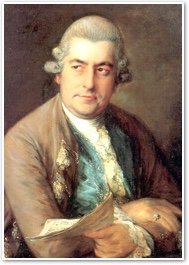Johann Christian Bach
- JOHN JANARO
This is a story about faith, conversion, and 18th century music.
 Johann Christian Bach
Johann Christian Bach 1735-1782
It is not some secret story (or speculation) about the man most people associate with the name "Bach," i.e., Johann Sebastian Bach (1685-1750), who is ranked among the greatest composers of all time. Indeed, the whole of Christianity has been greatly enriched by Johann Sebastian's prolific output of sacred music in which his musical genius and his own deep commitment to Christ (as a Lutheran) are both expressed. It must remain a mystery, however, why Protestantism's most outstanding sacred artist (some call him "the Fifth Evangelist") dedicated the final three years of his life and all the energies of his declining health to composing the epic, sublime Mass in B Minor.
At least we can say that the great Bach integrated faith and art in a way that enabled him to discover the ecumenism of beauty. He also bequeathed it to his heirs, above all his youngest son, Johann Christian Bach (1735-1782). Johann Christian branched out beyond his father's accomplishments to stand out in his own right. He moved from the churches and courts of Prussia to theaters and concert halls throughout Europe. He also took another step beyond his father and the rest of the Bach family by converting to the fullness of the Catholic Faith.
The young Johann Christian learned music from his father and older brothers, first in Leipzig and then in Berlin at the Prussian court. But in 1754, he made an important decision to travel to Italy to continue his education and begin his career. This would allow him to blend his German mastery of harmony and technique with the more popular Italian melodic style. More importantly, in Italy he met the man who would become both his musical and his spiritual "father": Padre Giovanni Battista Martini, one of the eminent musical scholars of the time and a Franciscan priest. Johann Christian spent several years under the tutelage of Padre Martini in Bologna and Milan, and devoted himself to the composition of sacred music. These early works — including two Masses, a Requiem, and hymns — are rich in music and inspiration.
Sometime before 1760 he became a Catholic. Most music historians consider his conversion to be merely a matter of professional convenience, since young Bach's benefactors had secured a position for him in the Milan cathedral. But this does not rule out the likelihood that his conversion was genuine. Bach encountered something new in Padre Martini: a man whose faith was integrated into artistic life. Bach saw that Christian life could be incarnated in a music profession that was in an expansive phase of artistic development, and that was also entering the broad sphere of secular entertainment. In fact, Johann Christian quickly moved from church music to opera. His early operas were a sensation in Milan and Naples. As a result, he was invited to England, where he worked under the royal patronage, and became a maestro in both the opera and public concert performances.
From then until his death after a brief illness in 1782, Johann Christian remained in contact with his mentor Padre Martini, and, though not a candidate for sainthood, he kept his Catholic Faith. Like his great father, but also in his own way, he showed forth the ecumenism of beauty.
 This is Meaghen Gonzalez, Editor of CERC. I hope you appreciated this piece. We curate these articles especially for believers like you.
This is Meaghen Gonzalez, Editor of CERC. I hope you appreciated this piece. We curate these articles especially for believers like you.
Please show your appreciation by making a $3 donation. CERC is entirely reader supported.

Acknowledgement
 John Janaro "Johann Christian Bach." Magnificat (June, 2017).
John Janaro "Johann Christian Bach." Magnificat (June, 2017).
Reprinted with permission of Magnificat.
The Author

 John Janaro is Associate Professor Emeritus of Theology at Christendom College. He is a Catholic theologian, and a writer, researcher, and lecturer on issues in religion and culture. He is the author of Never Give Up: My Life and God's Mercy and The Created Person and the Mystery of God: The Significance of Religion in Human Life. He is married to Eileen Janaro and has five children.
John Janaro is Associate Professor Emeritus of Theology at Christendom College. He is a Catholic theologian, and a writer, researcher, and lecturer on issues in religion and culture. He is the author of Never Give Up: My Life and God's Mercy and The Created Person and the Mystery of God: The Significance of Religion in Human Life. He is married to Eileen Janaro and has five children.




